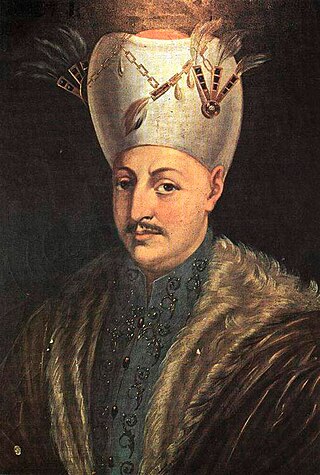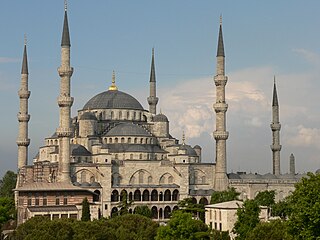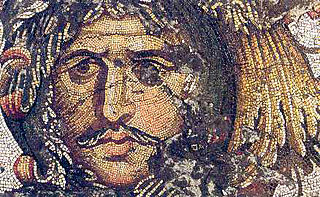
Ahmed I was the sultan of the Ottoman Empire from 1603 to 1617. Ahmed's reign is noteworthy for marking the first breach in the Ottoman tradition of royal fratricide; henceforth, Ottoman rulers would no longer systematically execute their brothers upon accession to the throne. He is also well known for his construction of the Blue Mosque, one of the most famous mosques in Turkey.

Ahmed II was the sultan of the Ottoman Empire from 1691 to 1695.

Murad III was the sultan of the Ottoman Empire from 1574 until his death in 1595. His rule saw battles with the Habsburgs and exhausting wars with the Safavids. The long-independent Morocco was for a time made a vassal of the empire but regained independence in 1582. His reign also saw the empire's expanding influence on the eastern coast of Africa. However, the empire was beset by increasing corruption and inflation from the New World which led to unrest among the Janissary and commoners. Relations with Elizabethan England were cemented during his reign, as both had a common enemy in the Spanish. He was also a great patron of the arts, commissioning the Siyer-i-Nebi and other illustrated manuscripts.

Mehmed III was the sultan of the Ottoman Empire from 1595 until his death in 1603. Mehmed was known for ordering the execution of his brothers and leading the army in the Long Turkish War, during which the Ottoman army was victorious at the decisive Battle of Keresztes. This victory was however undermined by some military losses such as in Győr and Nikopol. He also ordered the successful quelling of the Jelali rebellions. The sultan also communicated with the court of Elizabeth I on the grounds of stronger commercial relations and in the hopes of England to ally with the Ottomans against the Spanish.

Hagia Sophia, officially the Hagia Sophia Grand Mosque, is a mosque and former church serving as a major cultural and historical site in Istanbul, Turkey. The last of three church buildings to be successively erected on the site by the Eastern Roman Empire, it was completed in 537 CE. The site was a Greek Orthodox church from 360 CE to 1453, except for a brief time as a Latin Catholic church between the Fourth Crusade and 1261. After the fall of Constantinople in 1453, it served as a mosque until 1935, when it became a museum. In 2020, the site once again became a mosque.

Mimar Sinan also known as Koca Mi'mâr Sinân Âğâ, was the chief Ottoman architect, engineer and mathematician for sultans Suleiman the Magnificent, Selim II and Murad III. He was responsible for the construction of more than 300 major structures, including the Selimiye Mosque in Edirne, the Kanuni Sultan Suleiman Bridge in Büyükçekmece, and the Mehmed Paša Sokolović Bridge in Višegrad, as well as other more modest projects such as madrasa's, külliyes, and bridges. His apprentices would later design the Sultan Ahmed Mosque in Istanbul and the Stari Most bridge in Mostar.

The Basilica Cistern, or Cisterna Basilica, is the largest of several hundred ancient cisterns that lie beneath the city of Istanbul, Turkey. The cistern, located 150 metres (490 ft) southwest of the Hagia Sophia on the historical peninsula of Sarayburnu, was built in the 6th century during the reign of Byzantine emperor Justinian I. Today it is kept with little water, for public access inside the space.

Fatih is a municipality and district of Istanbul Province, Turkey. Its area is 15 km2, and its population is 368,227 (2022). It is home to almost all of the provincial authorities but not the courthouse. It encompasses the historical peninsula, coinciding with old Constantinople. In 2009, the district of Eminönü, which had been a separate municipality located at the tip of the peninsula, was once again remerged into Fatih because of its small population. Fatih is bordered by the Golden Horn to the north and the Sea of Marmara to the south, while the Western border is demarked by the Theodosian wall and the east by the Bosphorus Strait.

Ottoman architecture is an architectural style or tradition that developed under the Ottoman Empire over a long period, undergoing some significant changes during its history. It first emerged in northwestern Anatolia in the late 13th century and developed from earlier Seljuk Turkish architecture, with influences from Byzantine and Iranian architecture along with other architectural traditions in the Middle East. Early Ottoman architecture experimented with multiple building types over the course of the 13th to 15th centuries, progressively evolving into the classical Ottoman style of the 16th and 17th centuries. This style was a mixture of native Turkish tradition and influences from the Hagia Sophia, resulting in monumental mosque buildings focused around a high central dome with a varying number of semi-domes. The most important architect of the classical period is Mimar Sinan, whose major works include the Şehzade Mosque, Süleymaniye Mosque, and Selimiye Mosque. The second half of the 16th century also saw the apogee of certain decorative arts, most notably in the use of Iznik tiles.

Hagia Irene or Hagia Eirene, sometimes known also as Saint Irene, is an Eastern Orthodox church located in the outer courtyard of Topkapı Palace in Istanbul. It is the oldest known church in the city and one of the only Byzantine churches in Istanbul that was never converted into a mosque, alongside the Church of Saint Mary of the Mongols, as it was used as an arsenal for storing weapons until the 19th century. The Hagia Irene today operates as a museum and concert hall.

The Great Palace of Constantinople, also known as the Sacred Palace, was the large imperial Byzantine palace complex located in the south-eastern end of the peninsula now known as Old Istanbul, in modern Turkey. It served as the main imperial residence of the Eastern Roman emperors until 1081 and was the centre of imperial administration for over 690 years. Only a few remnants and fragments of its foundations have survived into the present day.

Handan Sultan was a consort of Ottoman Sultan Mehmed III, and mother and Valide Sultan to their son Sultan Ahmed I.
Istanbul is known as the City on the Seven Hills. The city has inherited this denomination from Byzantine Constantinople which – consciously following the model of Rome – was built on seven hills too.

The architecture of Istanbul describes a large mixture of structures which reflect the many influences that have made an indelible mark in all districts of the city. The ancient part of the city is still partially surrounded by the Walls of Constantinople, erected in the 5th century by Emperor Theodosius II to protect the city from invasion. The architecture inside the city proper contains buildings and structures which came from Byzantine, Genoese, Ottoman, and modern Turkish sources. The city has many architecturally significant entities. Throughout its long history, Istanbul has acquired a reputation for being a cultural and ethnic melting pot. As a result, there are many historical mosques, churches, synagogues, palaces, castles and towers to visit in the city.
Rabia Sultan was the Haseki Sultan of Sultan Ahmed II of the Ottoman Empire. She was the last woman to have the Haseki title.

The following outline is provided as an overview of and topical guide to Istanbul:

































